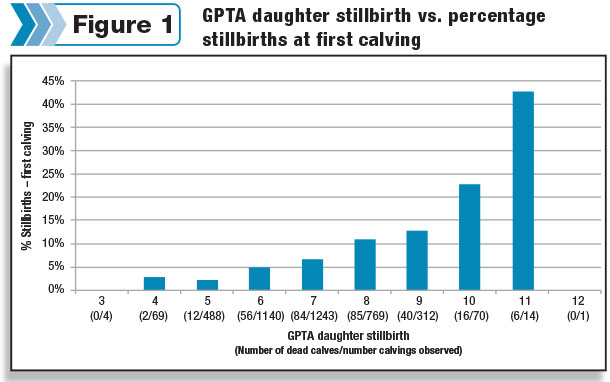Reproductive technologies like embryo transfer (ET) and in vitro fertilization can help advance the genetic level of heifers entering the milking herd, offering enhanced profits for producers. With the advent of genomic data, there is an even better story to tell.
Now producers can more confidently and accurately choose the best donors and recipients with genomic data to help ensure a more profitable embryo program. With the help of genomics, the gain producers can make is the difference in the predicted merit of the two heifers. In other words, if a producer has a donor that is net merit (NM) $700 and a recipient that is NM $100, they can expect an average profit of $600 over the lifetime of each ET heifer produced.
Looking forward, the profit from this improved population continues because half that gain in improvement is passed along to the next generation, and half again to the next, so that genetic improvements pass along multiple generations.
In the decision of whether to use heifers as recipients or allow them to have their own calf, how can producers know whether they are making the best investment? With genomics, producers are prepared with better information to more confidently make decisions on which animals the donor and recipients will be.
Like the donor, the recipient is an equally important part of the equation within ET programs. Genomics provides an abundance of valuable information on the overall genetic ability of the recipient. This information gives producers confidence they are making the best decision in selecting recipients to carry calves.
Using the lowest genetic merit heifers is generally good, but that’s not all
For increased profit, it is important to choose donors from the highest-ranking heifers for an economic index and then put their embryos into heifers of lower genetic merit, but not necessarily all animals of low genetic merit.
Producers might be tempted to use the very lowest heifers as recipients. While it may seem like the right choice to use the lowest-ranking heifers for an overall index trait like Net Merit Index (NM$) or Dairy Wellness Profit Index (DWP$), the very lowest heifers aren’t usually good at many of the things producers need dairy replacements to do for them, such as delivering live calves.
If producers use a standard index to rank heifers, such as NM$ or DWP$, it is important they select not only the lowest genomic heifers as recipients but also closely review traits offering insight into whether the recipient is likely to deliver a live calf. By missing this step, producers risk their recipient heifers (carrying valuable embryos) having increased potential for stillborn calves.
Additional genomic traits to watch for in recipient selection
Dairy producers should keep a watchful eye on potentially negative traits when selecting recipient heifers. Producers should look closely at the genomic-predicted transmitting ability (GPTA) for daughter stillbirths (DSB) on potential recipient heifers around the NM$ cutoff and consider using heifers as recipients with DSB rates of 8 percent or less, depending on the available pool of recipients (the lower, the better). A heifer that has a breed average of “8” has an 11 percent risk of stillbirth for her first calf.
It is very common to see the percentage of dead calves at birth increase significantly as DSB increases in the heifer carrying a calf. This is demonstrated in Figure 1, which summarizes herd data based on a heifer’s genomic DSB.

As the DSB trait is fairly new, many producers are not aware it exists, and it is difficult to even find what the parent average (PA) or pedigree index for a heifer would be. Prior to genomic testing and still yet today, producers consider selecting recipient heifers based on PA as an accurate selection process.
However, this option can present increased risks when producers invest in creating, developing and placing the embryo — ultimately relying on the recipient heifer to carry a live calf.
Using pedigree-based information like PA provides limited accuracy, due to the risk of incorrectly documented sires and grandsires. This option offers no information on individual traits, and the recipient could potentially be a better choice than the actual donor. Producers do not want to put valuable embryos into recipients that have a poorer chance of birthing a live calf.
Tips for selecting the best recipient and donor heifers
To make good investments with embryo transfer, producers need to be aware of the economic gain made from using the correct group of heifers as recipients versus other choices. Using genomic data, here are some valuable tips for making heifer selections:
- Choose donors from the highest heifers using an economic index, and then put their embryos into heifers of lower genetic merit, but not necessarily animals of the lowest merit. When investing in valuable embryo programs, the bigger the gap in donor and recipient genetic evaluation, the greater your potential return.
- Closely review data to screen for potentially poor but important traits, such as DSB, to know whether the recipient is likely to deliver a live calf.
- Avoid relying only on PA or other pedigree-based information. It provides limited accuracy due to the risk of incorrectly documented sires and grandsires, but more importantly, PA doesn’t consider the randomness of which genes pass on from the parents to the offspring. Genomic testing greatly helps reduce poor decisions by improving the accuracy of decisions that need to be made.
Using genomics to select recipient heifers is a tremendous jump forward in information available to producers. I look forward to seeing the dairy industry continue to progress and better the animals with the use of this technology. PD
References omitted but are available upon request. Click here to email an editor.
Daniel Weigel is the director of outcomes research at Zoetis.







